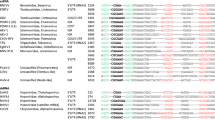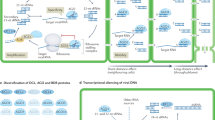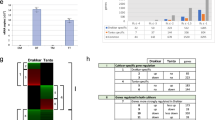Abstract
RNA silencing (also known as RNA interference) is a conserved biological response to double-stranded RNA that regulates gene expression, and has evolved in plants as a defence against viruses1,2,3. The response is mediated by small interfering RNAs (siRNAs), which guide the sequence-specific degradation of cognate messenger RNAs. As a counter-defence, many viruses encode proteins that specifically inhibit the silencing machinery3,4. The p19 protein from the tombusvirus is such a viral suppressor of RNA silencing5 and has been shown to bind specifically to siRNA6. Here, we report the 1.85-Å crystal structure of p19 bound to a 21-nucleotide siRNA, where the 19-base-pair RNA duplex is cradled within the concave face of a continuous eight-stranded β-sheet, formed across the p19 homodimer interface. Direct and water-mediated intermolecular contacts are restricted to the backbone phosphates and sugar 2′-OH groups, consistent with sequence-independent p19-siRNA recognition. Two α-helical ‘reading heads’ project from opposite ends of the p19 homodimer and position pairs of tryptophans for stacking over the terminal base pairs, thereby measuring and bracketing both ends of the siRNA duplex. Our structure provides an illustration of siRNA sequestering by a viral protein.
This is a preview of subscription content, access via your institution
Access options
Subscribe to this journal
Receive 51 print issues and online access
$199.00 per year
only $3.90 per issue
Buy this article
- Purchase on Springer Link
- Instant access to full article PDF
Prices may be subject to local taxes which are calculated during checkout




Similar content being viewed by others
References
Fire, A. et al. Potent and specific genetic interference by double-stranded RNA in Caenorhabditis elegans. Nature 391, 806–811 (1998)
Hannon, G. J. RNA interference. Nature 418, 244–251 (2002)
Voinnet, O. RNA silencing as a plant immune system against viruses. Trends Genet. 17, 449–459 (2001)
Li, W. X. & Ding, S. W. Viral suppressors of RNA silencing. Curr. Opin. Biotechnol. 12, 150–154 (2001)
Voinnet, O., Pinto, Y. M. & Baulcombe, D. C. Suppression of gene silencing: a general strategy used by diverse DNA and RNA viruses of plants. Proc. Natl Acad. Sci. USA 96, 14147–14152 (1999)
Silhavy, D. et al. A viral protein suppresses RNA silencing and binds silencing-generated, 21- to 25-nucleotide double-stranded RNAs. EMBO J. 21, 3070–3080 (2002)
Bernstein, E., Caudy, A. A., Hammond, S. M. & Hannon, G. J. Role for a bidentate ribonuclease in the initiation step of RNA interference. Nature 409, 363–366 (2001)
Elbashir, S. M., Martinez, J., Patkaniowska, A., Lendeckel, W. & Tuschl, T. Functional anatomy of siRNAs for mediating efficient RNAi in Drosophila melanogaster embryo lysate. EMBO J. 20, 6877–6888 (2001)
Ryter, J. M. & Schultz, S. C. Molecular basis of double-stranded RNA-protein interactions: structure of a dsRNA-binding domain complexed with dsRNA. EMBO J. 17, 7505–7513 (1998)
Ramos, A. et al. RNA recognition by a Staufen double-stranded RNA-binding domain. EMBO J. 19, 997–1009 (2000)
Hammond, S. M., Bernstein, E., Beach, D. & Hannon, G. J. An RNA-directed nuclease mediates post-transcriptional gene silencing in Drosophila cells. Nature 404, 293–296 (2000)
Dalmay, T., Hamilton, A., Rudd, S., Angell, S. & Baulcombe, D. C. An RNA-dependent RNA polymerase gene in Arabidopsis is required for posttranscriptional gene silencing mediated by a transgene but not by a virus. Cell 101, 543–553 (2000)
Mourrain, P. et al. Arabidopsis SGS2 and SGS3 genes are required for posttranscriptional gene silencing and natural virus resistance. Cell 101, 533–542 (2000)
Lipardi, C., Wei, Q. & Paterson, B. M. RNAi as random degradative PCR: siRNA primers convert mRNA into dsRNAs that are degraded to generate new siRNAs. Cell 107, 297–307 (2001)
Sijen, T. et al. On the role of RNA amplification in dsRNA-triggered gene silencing. Cell 107, 465–476 (2001)
Himber, C., Dunoyer, P., Moissiard, G., Ritzenthaler, C. & Voinnet, O. Transitivity-dependent and -independent cell-to-cell movement of RNA silencing. EMBO J. 22, 4523–4533 (2003)
Casimiro, D. R., Wright, P. E. & Dyson, H. J. PCR-based gene synthesis and protein NMR spectroscopy. Structure 5, 1407–1412 (1997)
Doublié, S. Preparation of selenomethionyl proteins for phase determination. Methods Enzymol. 276, 523–530 (1997)
Otwinowski, Z. & Minor, W. Processing of X-ray diffraction data collected in oscillation mode. Methods Enzymol. 276, 307–326 (1997)
Brünger, A. T. et al. Crystallography & NMR system: A new software suite for macromolecular structure determination. Acta Crystallogr. D 54, 905–921 (1998)
Terwilliger, T. C. Automated main-chain model-building by template-matching and iterative fragment extension. Acta Crystallogr. D 59, 34–44 (2002)
Jones, T. & Kjeldgaard, M. Electron-density map interpretation. Methods Enzymol. 227, 174–208 (1997)
Nicholls, A., Sharp, K. A. & Honig, B. Protein folding and association: insights from the interfacial and thermodynamic properties of hydrocarbons. Proteins 11, 281–296 (1991)
Lavery, R. & Sklenar, H. The definition of generalized helicoidal parameters and of axis curvature for irregular nucleic acids. J. Biomol. Struct. Dyn. 6, 63–91 (1988)
Acknowledgements
We thank members of the Patel laboratory for stimulating discussions and A. Teplov for assistance with data collection. This research was supported by NIH. We thank the personnel at beamline 14IDB of the Advanced Photon Source (APS) for their assistance. Use of this APS beamline was supported by the US Department of Energy, Basic Energy Sciences, Office of Science.
Author information
Authors and Affiliations
Corresponding author
Ethics declarations
Competing interests
The authors declare that they have no competing financial interests.
Supplementary information
Rights and permissions
About this article
Cite this article
Ye, K., Malinina, L. & Patel, D. Recognition of small interfering RNA by a viral suppressor of RNA silencing. Nature 426, 874–878 (2003). https://doi.org/10.1038/nature02213
Received:
Accepted:
Published:
Issue Date:
DOI: https://doi.org/10.1038/nature02213
This article is cited by
-
ARGONAUTE 1: a node coordinating plant disease resistance with growth and development
Phytopathology Research (2023)
-
Protein-based vehicles for biomimetic RNAi delivery
Journal of Biological Engineering (2019)
-
Identification and localization of Tospovirus genus-wide conserved residues in 3D models of the nucleocapsid and the silencing suppressor proteins
Virology Journal (2019)
-
Inhibition of dicer activity in lepidopteran and dipteran cells by baculovirus-mediated expression of Flock House virus B2
Scientific Reports (2019)
-
Identification and characterisation of a glycine-rich RNA-binding protein as an endogenous suppressor of RNA silencing from Nicotiana glutinosa
Planta (2019)
Comments
By submitting a comment you agree to abide by our Terms and Community Guidelines. If you find something abusive or that does not comply with our terms or guidelines please flag it as inappropriate.



